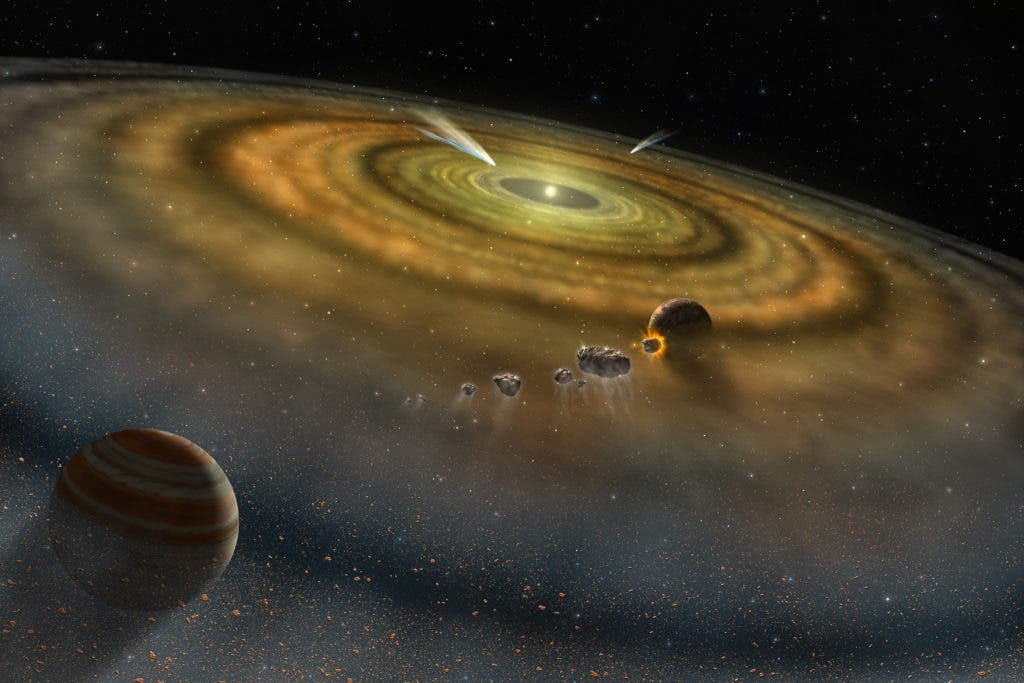Jupiter is the biggest, most massive — and according to the latest research — oldest planet in our solar system. The news comes from the Lawrence Livermore National Laboratory where American researchers, with the help of German colleagues at the University of Münsterin, found Jupiter must have formed just one million years after the solar system was established. Knowing how old Jupiter is will help astronomers better understand how the grand solar system itself evolved to its current architecture.

The Universe is about 13.7 billion years old, according to current estimates. The Sun, planets, asteroids, and comets that make up our solar system are much younger, though. Their story first started some 4.55 billion years ago when a cloud of interstellar dust and gas was all there was. A nearby supernova explosion blasted new energy into the cloud which began to collapse on itself. Most of the material condensed in the center of the cloud to form the sun, with only 1% remaining in orbit around the new star.
In time, all of the leftover gas and dust particles will clump together due to electrostatic and gravitational attraction in a process called accretion. Computer models show that in only a few million years, several thousand bodies the size of large asteroids will coalesce into larger units that we now see as planets. It was never clear, however, what was the first planet.
By looking at tungsten and molybdenum isotopes on iron meteorites, researchers found these are made from two distinct nebular sources that coexisted but remained separated between 1 and 3-4 million years after the solar system formed. According to a model run on this data, the most plausible explanation is that the nebula was separated by an intruding early Jupiter.
“The most plausible mechanism for this efficient separation is the formation of Jupiter, opening a gap in the disc (a plane of gas and dust from stars) and preventing the exchange of material between the two reservoirs,” said Thomas Kruijer, lead author of the paper published Proceedings of the National Academy of Sciences. “Jupiter is the oldest planet of the solar system, and its solid core formed well before the solar nebula gas dissipated, consistent with the core accretion model for giant planet formation.”
Because Jupiter is so massive, if it really was the first planet to form, it must have had a big effect on the dynamics of the solar accretion disk. Scientists always knew Jupiter must have formed early but its formation was never accurately dated.
The problem has always been the lack of samples from Jupiter, like the ones we have from Earth, Mars, or the moon. Our next best thing is meteorites derived from asteroids which must have formed at the dawn of the solar system.
The isotopic analysis suggests Jupiter’s core formed within 1 million years and continued to grow to 50 Earth masses until 3-4 million years after the solar system formed. This timeframe bodes well with our current best models that explain how gas giants such as Jupiter or Saturn form. These suggest that the gas giant’s core must have formed before the dissipation of the solar nebula (up to 10 million years after the solar system formed) in order to accumulate gas onto the core.
“Our measurements show that the growth of Jupiter can be dated using the distinct genetic heritage and formation times of meteorites,” Kruijer said.
This isn’t the final word though. For instance, some models have suggested Jupiter doesn’t even have a core. Instead, dust and gas condensed into a gas giant. According to data obtained by the Juno probe, the truth might lie somewhere in between — a mushy core that might even be larger than current estimates. Whatever’s the case, Jupiter seems full of surprises these days. Just today, ZME Science reported scientists found two new Jovian moons — that’s 69 moons in total!


